
Before putting the Composting Toilet Biolaneco to use
Make sure that the air channel inside the compost tank is still in place after transportation. The channel must rest on the sill on the inside wall of the tank so that the inlet air valve above the emptying door will allow unobstructed airflow into the air channel. The air inlet valve cannot be adjusted.
Put a layer approximately 5 cm thick (about 20 l) of Biolan Compost and Toilet Bulking Material on the bottom of the Biolan Composting Toileteco to prevent the liquid separator plate from getting blocked.
Operation of the Composting Toilet Biolaneco
The patented ventilation system of the Composting Toilet Biolaneco ensures the composting is efficient and the toilet space remains odourless. Major part of the liquids evaporates during composting. The liquid separator on the bottom of the compost tank separates the excess liquid at the load peaks and collects it in a canister.
Because no chemicals or additives are required, the Composting Toilet Biolaneco benefits from a low operating cost. The bark-based Biolan Compost and Toilet Bulking Material is suitable for bedding.
Using the Composting Toilet Biolaneco
The proper use of the Composting Toilet Biolaneco allows efficient composting of the mass and enables convenient use and emptying of the toilet. Thanks to the thermal insulation of the toilet, composting of the waste is efficient and thus the capacity of the toilet unit is increased as the waste is greatly compressed as a result of decomposition.
The composting process starts as soon as there is a sufficient amount of waste in the composter, i.e. normally the unit is half-full of waste. The composting process is understood to start when the temperature of the mass inside the toilet rises above the outside air temperature. The temperature is raised and maintained by the vital functions of the micro-organisms that are created in the composter provided that waste is added regularly. After start-up, the waste reaches the cover soil stage in 6-7 weeks.
The amount of seep liquid created is greatest at the start, but is reduced as a result of warming up of the compost mass and evaporation.
Adjusting the replacement air valve in the seat top
Ventilation of the toilet is controlled using the replacement air valve in the seat top. Keep the replacement air valve open during summer to ensure the ventilation remains efficient and the evaporation of liquids intensive. Keep the replacement air valve almost closed during winter to reduce heat loss from the compost. When the toilet is not in use, keep the seat lid closed to ensure correct operation of the ventilation.
Air channel in the toilet tank
The operation of the Biolan Composting Toileteco is very efficient thanks to the air channel located inside the composting unit. The channel brings the air required by the compost to the centre of the compost mass; to the layer where it is most needed. At the same time, the air channel prevents the compost mass from packing on the bottom and keeps the mass elevated during emptying. The air channel is visible at the initial stage, but after that, it is virtually obscured by the mass all the time.
Adjusting the inlet air valve above the emptying door
The inlet air valve above the emptying door cannot be adjusted. Its purpose is to bring air into the air channel.
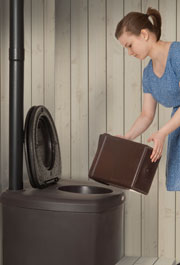 What can be placed in the Composting Toileteco
What can be placed in the Composting Toileteco
The Biolan Composting Toilet Biolaneco is intended for composting toilet waste as well as household bio-waste.Kitchen waste intensifies the composting process by balancing and diversifying the nutrition base of the compost. On the other hand, there are risks involved in composting kitchen waste. Pieces of meat and fish, especially when left in the open may attract flies into the compost tank. Cover the waste with bulking material with care.
Do not put into the toilet anything that hampers the composting process or does not compost, such as:
- debris, sanitary towels
- chemicals, lime
- detergents, washing water
- ash, cigarette butts, matches
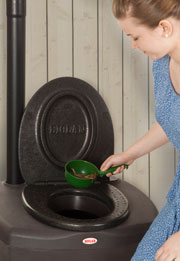
You can put into the toilet paper towelettes intended for cleaning hands or for intimate hygiene.
Using bulking material
After every time the toilet is used, apply approximately 0.2-0.5 litres of Biolan Compost and Toilet Bulking Material over the left matter. Note that bulking material must also be applied after urinating. Applying suitable bulking material is essential for proper operation of the toilet.
Using the activator
Do not use activator in the toilet. It is not necessary, as the nitrogen content of the toilet waste is sufficient even without addition of the activator.
Year-round use of the Composting Toilet Biolaneco
In a toilet located in a non-heated space, the mass will cool down and may even freeze in severe frost or if the use is occasional. Freezing damages neither the unit nor the compost mass itself and the composting process continues when the temperature rises.
To reduce leakage of the seep liquid, we recommend using a double dosage of Biolan Compost and Toilet Bulking Material in the winter.
Empty the seep liquid canister in the autumn to prevent it from cracking due to freezing. Empty the toilet unit approximately to half-full in the autumn to provide space for the mass that will accumulate in the winter. If the toilet is to be used daily also during the cold season, locate the unit
in a heated space.
Cleaning the Composting Toilet Biolaneco
As required, you can remove the thermal seat of the Composting Toilet Biolaneco, and wash it using any common domestic cleaning agents. Likewise, you can wash the unit externally using domestic cleaning agents. There is no need to wash the toilet tank internally when emptying it.
Check the seep liquid pipe and the liquid separator plate as well as the seep liquid chute below it once a year and clean them, as required.
Emptying the Composting Toilet Biolaneco
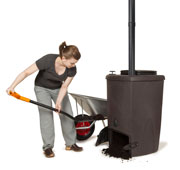
Only empty from the Composting Toilet Biolaneco compost that has reached the cover soil stage, and leave the raw waste still in the tank. To enable an efficient uninterrupted composting process, we recommend that no more than half of the mass be discharged from the unit at a time. Toilet waste matures to cover soil stage in 5–8 weeks, after which it can be discharged. Do not empty the tank until it has become full for the first time. There is no need to wash the toilet tank internally when emptying it.
Toilet waste can be so tough that it does not drop down onto the bottom of the toilet unit by itself after the emptying. If this is the case, push the mass down using a stick or the Compostmixer. This is easiest to begin from the corners. Be careful not to break the air channel in the centre of the toilet unit.
If the toilet is to be used only in summer, empty it in spring before using it for the first time. The emptying process is most convenient and easiest at this stage. If the compost mass is still frozen during emptying, thaw it by pouring a bucket of hot water through the seat ring opening a few hours before emptying.
Emptying the seep liquid canister
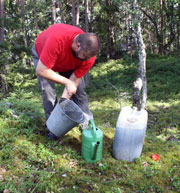 Keep an eye on the filling pace of the seep liquid canister, in particular at the initial stage of use, until the emptying interval settles down. Empty the seep liquid canister as required, however, at least once a year. You can utilise the seep liquid, that is rich in nutrients, as a source of nitrogen for compost. This intensifies the activity of the garden compost in particular, which is poor in nutrients but rich in carbon. This way, you do not have to dilute the seep liquid.
Keep an eye on the filling pace of the seep liquid canister, in particular at the initial stage of use, until the emptying interval settles down. Empty the seep liquid canister as required, however, at least once a year. You can utilise the seep liquid, that is rich in nutrients, as a source of nitrogen for compost. This intensifies the activity of the garden compost in particular, which is poor in nutrients but rich in carbon. This way, you do not have to dilute the seep liquid.
You can also use seep liquid as fertiliser for ornamental plants in the yard and garden. A safe dilution ratio is 1:5. Undiluted seep liquid can also be used, but then you must water the area carefully after the application to avoid early blight. Fertilising in the autumn is not recommended so as not to disturb the preparation of perennial plants for winter. The recommended storing time for the seep liquid before use as fertiliser is approximately one year.

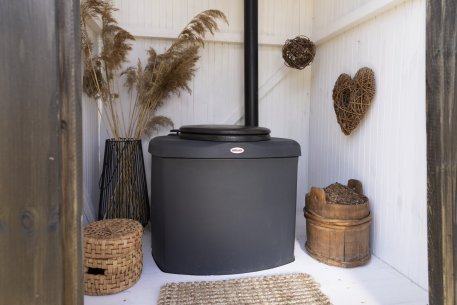
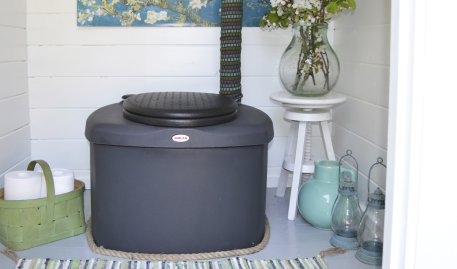



 For more ecological life!
For more ecological life!





 What can be placed in the Composting Toileteco
What can be placed in the Composting Toileteco

 Keep an eye on the filling pace of the seep liquid canister, in particular at the initial stage of use, until the emptying interval settles down. Empty the seep liquid canister as required, however, at least once a year. You can utilise the seep liquid, that is rich in nutrients, as a source of nitrogen for compost. This intensifies the activity of the garden compost in particular, which is poor in nutrients but rich in carbon. This way, you do not have to dilute the seep liquid.
Keep an eye on the filling pace of the seep liquid canister, in particular at the initial stage of use, until the emptying interval settles down. Empty the seep liquid canister as required, however, at least once a year. You can utilise the seep liquid, that is rich in nutrients, as a source of nitrogen for compost. This intensifies the activity of the garden compost in particular, which is poor in nutrients but rich in carbon. This way, you do not have to dilute the seep liquid. Locating the Composting Toilet Biolaneco in the toilet space
Locating the Composting Toilet Biolaneco in the toilet space